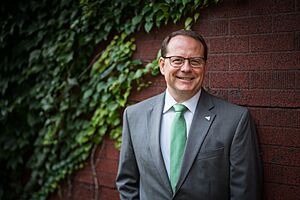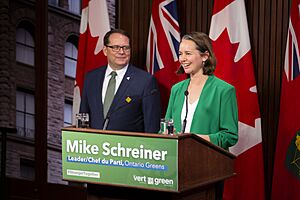Green Party of Ontario facts for kids
Quick facts for kids
Green Party of Ontario
Parti vert de l'Ontario
|
|
|---|---|
 |
|
| Abbreviation | GPO PVO |
| Leader | Mike Schreiner |
| President | Ard Van Leeuwen |
| Deputy leaders | Aislinn Clancy Matt Richter |
| Founded | 1983 |
| Headquarters | Suite 232, 67 Mowat Avenue, Toronto, Ontario, Canada |
| Ideology | Green politics |
| Political position | Centre-left |
| Colours | Green |
| Seats in the Legislature |
2 / 124
|
The Green Party of Ontario (GPO), also known as the Parti vert de l'Ontario in French, is a political party in Ontario, Canada. This party focuses on green politics, which means they care a lot about the environment.
The party is currently led by Mike Schreiner. He became a MPP for Guelph in 2018. This was a big moment because he was the first Green Party member to be elected to the Ontario Legislative Assembly. In 2023, Aislinn Clancy also became an MPP after winning an election in Kitchener Centre. This meant the Green Party had two members in the provincial government.
The Green Party of Ontario officially started in 1983. Over the years, they have run candidates in many elections. In 2007, they had candidates in every area of Ontario and received over 8% of all votes. Their popularity grew again, and in the 2022 election, they received almost 6% of the votes.
Contents
History of the Green Party
How the Party Started
The Green Party of Ontario became an official political party in 1983. It was registered with Elections Ontario, which manages elections in the province. Soon after, the party took part in its first election. They had nine candidates and received about 5,300 votes.
In the 1987 election, they again ran nine candidates. In 1990, the party had 40 candidates and received more votes, about 30,400.
Early Leaders and Growth
The party elected Frank de Jong as its first official leader in 1993. He led the party through three election campaigns. During this time, the party's support slowly grew. By the 2007 provincial election, they had gained over 8% of the votes.
In the 2003 provincial election, the Green Party of Ontario saw a big increase in votes. They ran 102 candidates out of 103 possible spots. They received about 126,700 votes, which was 2.82% of the total. The party even finished ahead of the Ontario New Democratic Party in two areas.
Around 2006, the party made some important changes to its rules. They created a larger Provincial Executive, which is like a main committee. This committee included representatives from different regions and also had Deputy Leaders. These changes helped the party get ready for the 2007 provincial election.
Under Frank de Jong's leadership, the party ran a full group of 107 candidates in the 2007 election. They received over 355,000 votes, which was more than 8% of the total. This was the first time the Greens' support reached double-digits in some polls before an election.
Even though they did not elect a member to the Ontario Legislative Assembly in 2007, their share of the popular vote increased significantly. Shane Jolley, a Green candidate, received more votes than any other Green candidate in Canadian history at that time.
Frank de Jong announced he was stepping down as leader in May 2009. A new leader was chosen in November 2009.
After de Jong, Mike Schreiner became the new leader. He was the only person running for the position. The Greens did not win any seats in the 2011 and 2014 provincial elections. However, Schreiner received 19% of the votes in Guelph in 2014.
2018: A Big Step Forward
In the 2018 Ontario general election, which was Mike Schreiner's third election as leader, the party focused on several key ideas. They wanted to invest in green jobs and clean energy. They also supported a universal basic income and better mental health services. For the first time, more than half of their candidates were women.
Mike Schreiner was not included in the televised debates for leaders. This led to a campaign asking media to change their decision.
Before the election, the Toronto Star newspaper said that Schreiner was the best candidate in Guelph. They called him "the most forthright leader" in the campaign. The Guelph Mercury also supported Schreiner, giving ten reasons why he was the best choice for Guelph.
Schreiner's campaign was successful. He was elected as the first ever Green MPP in Ontario's history. He received 45% of the votes in the Guelph area, which was a huge increase for the party.
2022–2023: Growing Stronger
Mike Schreiner was re-elected in the 2022 Ontario general election. He was again the only Green candidate to win a seat. The party almost won another seat in Parry Sound—Muskoka. Green candidate Matt Richter came in second place, losing by just over 2,100 votes.
The party elected its second MPP in 2023. Green candidate and deputy leader Aislinn Clancy won a special election in Kitchener Centre. This doubled the number of Green representatives in the Legislature. Clancy won almost 48% of the votes, clearly beating the other candidates.
Green Party Policies
The Green Party of Ontario believes in values shared by Green parties around the world. These include:
- Participatory democracy: Everyone should have a say in decisions.
- Nonviolence: Solving problems without fighting.
- Social justice: Making sure everyone is treated fairly.
- Sustainability: Using resources wisely so they last for the future.
- Respect for diversity: Valuing all different kinds of people and ideas.
- Ecological wisdom: Understanding and protecting nature.
The party describes itself as socially progressive, meaning they support fairness and equality. They are also environmentally focused and fiscally responsible, which means they try to manage money carefully.
Before the 2022 election, the party released plans about housing, climate change, and mental health. Their 2022 plan had three main goals:
- A caring society: Improving healthcare, education, and social services for everyone.
- Connected communities: Making housing more affordable by building more homes in existing areas. They also want to protect renters and stop housing speculation.
- New climate economy: Reaching net-zero emissions by 2045. This means replacing fossil fuels with clean energy, creating green jobs, and protecting the environment.
Housing Plans
The Green Party wants to change zoning laws to allow more types of homes to be built. They believe building homes in existing areas is better for the environment and costs less than building new developments far away.
Their elected members have also asked for stronger protections for people who rent homes. They want the province to work with non-profit groups to build affordable homes that are not just for profit.
The party's housing plan, released in 2021, had seven ideas to create "more liveable and affordable communities." These included building diverse neighborhoods, protecting farmland from new developments, and increasing affordable housing. They also want to end homelessness, protect renters, and stop people from buying and selling homes just to make quick money. The Toronto Star newspaper supported this plan, calling it "ambitious."
Climate Action
The Green Party supports stopping the use of fossil fuels and switching to renewable energy sources. Their plan includes ways to make electric vehicles more affordable and easier to use. They also want to update homes and businesses to use less energy. Their goal is to reach net-zero emissions by 2045.
The party does not support building new nuclear power plants. They have also asked for an end to the ban on offshore wind power to get more clean energy.
Greens want stronger protections for wetlands and farmland. Party leader Mike Schreiner spoke out against the Ford government's plan to build on southern Ontario's Greenbelt. This plan was later stopped in 2023.
Healthcare Ideas
The Greens' healthcare policies focus on preventing illness. They want to invest more in things that affect health, like social connections, stable housing, and reducing poverty. They also want to work with the federal government to create universal programs for prescription medicine and dental care. The party wants to improve how public healthcare workers are hired, kept, and kept safe. They support a healthcare system that is funded and run by the public, and they do not want healthcare services to be privatized.
The party supports a non-profit system for long-term care homes. They want to stop for-profit long-term care homes and increase funding for this area. In their 2022 plan, the party promised to build many new long-term care beds by 2033 and even more by 2041.
In 2022, the party released a plan for mental health. They called for more access to mental health and addiction care under OHIP. They also asked for an immediate 8% increase in funding for community mental health services.
Education Goals
The party's education plan includes updating how schools are funded. They want to make sure there is enough money for special education and for schools in rural and remote areas.
The party supports learning in person at school. They do not want mandatory online learning or mixed learning models. They have also called for an end to EQAO standardized tests.
In the 2022 Ontario general election, the party promised to limit class sizes. They want no more than 24 students in elementary classes for grades four to eight, and no more than 26 students in kindergarten classes.
For colleges and universities, the party wants to increase funding. They also want to reverse cuts to the OSAP. This would mean turning loans into grants for students from low- and middle-income families. They also want to remove interest charges on student debt.
During the 2007 provincial election, education was a big topic, especially the funding of religious schools. The Green Party's policy is to end the publicly funded Catholic school system. They believe combining the systems would save millions of dollars by avoiding duplicate costs.
Social Programs
The Green Party of Ontario believes in updating social support programs for today's challenges. They have asked for the doubling of payments for the Ontario Disability Support Program and Ontario Works.
They also support a universal Basic Income for all Ontarians. This would provide financial security while also reducing complicated rules.
The party supports ten-dollar-a-day daycare. In their 2022 plan, they promised to work with the federal government to ensure continued funding for this program.
During the COVID-19 pandemic, Green party leader Mike Schreiner asked for more paid sick days for workers. He wanted the number to increase from three to ten. He also called for a ban on employers requiring sick notes from employees who take time off due to illness.
Electoral Reform
The Green Party of Ontario strongly supports electoral reform. In their 2022 election plan, they called for a "Citizens Assembly on electoral reform." This group would be made up of diverse, randomly chosen people. Their job would be to suggest ways to update Ontario's election system so it better reflects what voters want.
Taxation Ideas
Historically, Greens have supported tax breaks for small businesses. They usually suggest paying for this by slightly increasing the tax rate for large companies. They have also suggested charging fees for roads, including tolls and parking fees, to help pay for public transit.
The party has proposed several tax ideas to reduce speculation in the housing market. These include a multi-homes tax for people or companies owning more than two homes. They also suggest a vacant homes tax and a tax on quickly selling properties for profit.
The party supports a carbon fee-and-dividend approach to pollution pricing. This means charging a fee for carbon pollution and giving all the money collected from individuals back to them as dividends. In their 2022 plan, they proposed taking over the federal carbon pricing system. They would increase the price by $25 each year until it reaches $300 per tonne.
Party leaders
| Picture | Name | Term start | Term end | Riding(s) contested as Leader | Notes | ||||||||
|---|---|---|---|---|---|---|---|---|---|---|---|---|---|
 |
Frank de Jong | 1993 | 2009 |
|
First Leader, elected in 1993. Later served as Leader of the Yukon Green Party (2016–2019). | ||||||||
 |
Mike Schreiner | November 2009 | Incumbent | Simcoe—Grey (2011) – Loss Guelph (2014) – Loss Guelph (2018) – Won Guelph (2022) – Won |
Elected Leader in 2009. First leader to win a seat in the Ontario legislature (2018-present). |
Elected Greens
- 2018, 2022: Mike Schreiner, elected in Guelph
- 2023 by-election: Aislinn Clancy, elected in Kitchener Centre
Election results
| Election | Leader | # of seats | Change +/− | # of votes | % of popular vote | Standing | Legislative role | Government |
|---|---|---|---|---|---|---|---|---|
| 1985 | N/A |
0 / 125
|
New Party | 5,345 | 0.14% | New Party | Extra-parliamentary | Progressive Conservative minority defeated in no confidence vote, replaced by Liberal minority |
| 1987 |
0 / 130
|
3,398 | 0.1% | Extra-parliamentary | Liberal majority | |||
| 1990 |
0 / 130
|
30,097 | 0.75% | Extra-parliamentary | NDP majority | |||
| 1995 | Frank de Jong |
0 / 130
|
14,108 | 0.34% | Extra-parliamentary | Progressive Conservative majority | ||
| 1999 |
0 / 103
|
30,749 | 0.79% | Extra-parliamentary | ||||
| 2003 |
0 / 103
|
126,651 | 2.82% | Extra-parliamentary | Liberal majority | |||
| 2007 |
0 / 107
|
354,897 | 8.02% | Extra-parliamentary | Liberal majority | |||
| 2011 | Mike Schreiner |
0 / 107
|
126,567 | 2.94% | Extra-parliamentary | Liberal minority | ||
| 2014 |
0 / 107
|
233,269 | 4.84% | Extra-parliamentary | Liberal majority | |||
| 2018 |
1 / 124
|
264,094 | 4.64% | No status | Progressive Conservative majority | |||
| 2022 |
1 / 124
|
276,704 | 5.98% | No status | Progressive Conservative majority | |||
| 2025 |
2 / 124
|
242,822 | 4.83% | No status | Progressive Conservative majority |
See also
- Green Party of Ontario candidates in Ontario provincial elections
- List of Green party leaders in Canada
- List of Green Party of Ontario candidates
- List of Green politicians who have held office in Canada
- List of Ontario general elections
- List of political parties in Ontario
- Politics of Ontario




